The pivot point is one of the most widely used indicators in day trading. This tool provides special plots of 7 support and resistance levels to find turning points during the day in the market.
Below is how it appears on the AUD/JPY currency pair on the 1-hour chart. You can see all 7 levels.
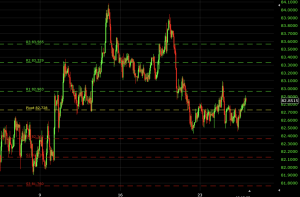
Traders often find their support and resistance levels by looking for previous turning points in the market, while pivot points are displayed automatically on a daily basis. Because many market participants track these levels, prices tend to respond to them.
Calculation of pivot points
Pivot points can be calculated for different timeframes in some charting software programs that allow the indicators to be customized. For example, some programs may calculate pivot points at weekly or monthly intervals. Standard indicators, however, are presented at a daily level.
The central price level (pivot point) is the high and low of the market and is calculated as a function of the market close to the previous day (or more commonly the period). Add up these values and divide by 3. This is the same concept as “general price”.
Pivot Point = [High (previous) + Low (previous) + Close (previous)] / 3
The remaining 6 price levels (three support levels and three resistance levels) all use the value of the pivot point as part of their calculations.
The three support levels are conveniently called Support 1, Support 2, and Support 3. The three resistance levels are called Resistance 1, Resistance 2 and Resistance 3. S1, S2, S3 and R1, R2, R3.
This value is calculated as:
- Resistance 1 = (2 x Pivot Point) – Low (previous period)
- Support 1 = (2 x Pivot Points) – High (previous period)
- Resistance 2 = (Pivot Point – Support 1) + Resistance 1
- Support 2 = Pivot Point – (Resistance 1 – Support 1)
- Resistance 3 = (Pivot Point – Support 2) + Resistance 2
- Support 3 = Pivot Point – (Resistance 2 – Support 2)
Because price levels are based on the previous day’s high, low, and close, the wider the range between these values, the greater the distance between the levels on the next trading day. Similarly, the smaller the trading range, the lower the distance between levels the next day.
Not all levels are necessarily charted at once. This simply means that the scale of the price chart prevents some levels from being included in the viewing window.
Uses of pivot points
Pivot points were initially used in the stock and futures markets, but have been adapted for daily trading in the foreign exchange market.
Pivot points have the advantage of being leading indicators. In other words, traders can use this indicator to gauge potential turning points in the market in advance. They can be used as support or resistance or act as trade entry targets with trade loss targets and/or take profit levels.
For example below, several cases from S1 serve as support.
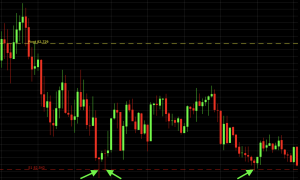
The pivot point, which is the centerline, and the level at which everything else is calculated is the main focus. If the price is trading above the pivot point, market sentiment can be considered bullish for the day (however, if this is the case, the market may still fall).
When the market is stationary, prices can drift around the volatile points. You can observe this type of price action in the chart below.
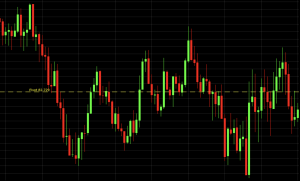
R1, R2 and R3 are mentioned in the sense that they are likely to act as resistance as the market moves up, but can also act as support if the price moves down if the price rises above it. Same for S1, S2 and S3. This can act as resistance when backing up when it breaks with support.
For example, resistance levels play a supporting role here.

Use pivot points for measure probabilities
Some traders use pivot points to predict possible price movements. Depending on the market, generally the following probabilities are reported based on the likelihood that the price will close the trading day above or below the next day.
- Higher than R1 40% of the time
- Less than S1 40% of the time
- Higher than R2 15% of the time
- Less than S2 15% of the time
- Higher than R3 5% of time
- Less than S3 5% of the time
Of course, this is a rough approximation. Simply because price moves above or below an external level does not necessarily mean that the move is not valid or sustainable. For example, you should not assume that if you take a long position when the price reaches S2, you have an 85% chance of winning the trade based on the information above. Certainly not true per se.
Pivot points as stop-losses
Some traders place trades at a level where they expect to cancel the trade, while trades below (for long trades) or above (for short trades) are used as stop-losses.
For example:

Here we see a short entry on R1 and a stop loss on R2.
Trading using pivot points
At this point, it would seem pretty straightforward to use pivot points as expected turning points in the market. Taking a trade at this level in the direction of an expected reversal is a very common technical strategy.
To increase the viability of this strategy, traders link pivot point strategies to other indicators. For example, you can use a 50-period simple moving average to measure a trend and bias your trades only in the direction of that trend.
Also, instead of first touching the pivot level, you may need a secondary touch to ensure the level is valid as a turning point. Below is a best example of “checking” the validity of a level before trading with primary contact. This is a 5 minute chart of EUR/USD.

When data or news comes out, trading volume increases significantly and previous trading moves and support and resistance levels throughout the day can quickly become obsolete. On the large green bar, price actually held between the two pivot levels. However, every time we touched the pivot, we would have placed long and short trades in 5 minutes.
After that, the market went bullish and fell steadily, making it insensitive to pivot points.
So, when there is a large trade in the market, you need to be careful not to try to trade at a level that the market is not willing to respect.
If I had to write a rule for this system:
1. a) When the 50 simple moving average is sloping positively, only trade long term.
b) If the 50-period simple moving average is negatively sloping, only trade short.
2. Place a trade on the 2nd touch of the pivot level after confirming that the 1st touch is the rejection of the level.
This applies to the 5 minute chart, but can also be applied to higher (or lower) time compressions.
For day traders using daily pivot points, 5-minute to hourly charts make the most sense. Swing traders are best suited to apply the strategy from the 4-hour chart to the daily chart using weekly pivot points. Position traders are probably best suited to using monthly pivot points on daily or weekly charts.
However, this is a fairly simple system that can be effective.
yes
Here is a 5 minute chart of the EUR/USD currency pair.
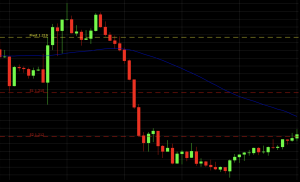
The price is in a downtrend for the day, the price bounces once from the S2 level (acting as resistance) as the price retraces, leading to a short trade on the 2nd touch of S2.
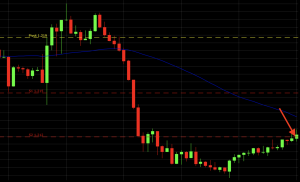
This trade worked well after continuing the downtrend shortly thereafter.
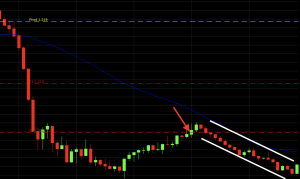
Of course, the question is how do you decide where you can go?
You must have an exit plan before making any trades. This can take many forms.
The diagram below shows several options.
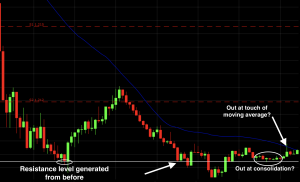
A level of resistance forms immediately after the trade starts moving in our direction. Naturally, it might be reasonable to expect resistance to form again later.
Additionally, you may choose to exit the trade once the price starts consolidating and the momentum of the trend or overall market size dissipates.
Alternatively, you can touch a moving average. Some traders use the more popular moving averages (50, 100 and/or 200 cycles) as support and resistance levels, or consider a change in trend when the price reaches a level above the moving average.
The natural beneficiary of the pivot point system is, of course, the next step in the hierarchy. In this case, our take profit level may be S3 if we short trade at S2. However, as mentioned before, reaching the outermost levels like S3 and R3 is usually rare.
It is perfectly fine for day traders to close their trades near the end of the day when the volume ends.
A word about time zones
Pivot points are time zone sensitive. Most pivot points are based on closing prices in New York or London.
So anyone using charting software with closing times based on San Francisco or Tokyo or other time zones may see different pivot points on their charts, which may not follow on a large scale internationally. This can cause it to be muted or have no value.
Therefore, it is recommended to set the chart time to either New York time or London time. Both cities observe daylight saving time, so the relationship to GMT or UTC is different for each location on the calendar.
No matter which timeframe you choose, you can backtest your pivot points with previous price data. It is important to ensure that prices are sensitive to these levels in the markets you trade.
Conclusion
Pivot points provide an at-a-glance view of potential future support and resistance levels in the market. This can be especially useful for traders as a key indicator of where price may turn or consolidate. It can also be used as a stop-loss or take-profit level.
While daily pivot points are the most common and best suited for day traders, some charting platforms allow charts to be displayed for other timeframes as well (e.g. weekly, monthly).
As with all indicators, it should not be used as the only indicator on which to base your trades. It should be used in conjunction with other forms of analysis and/or other technical indicators.








